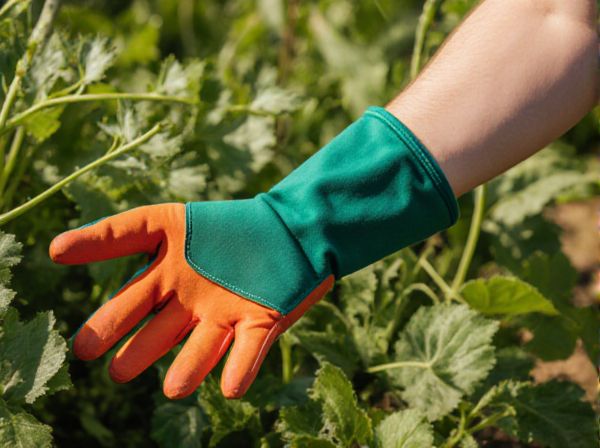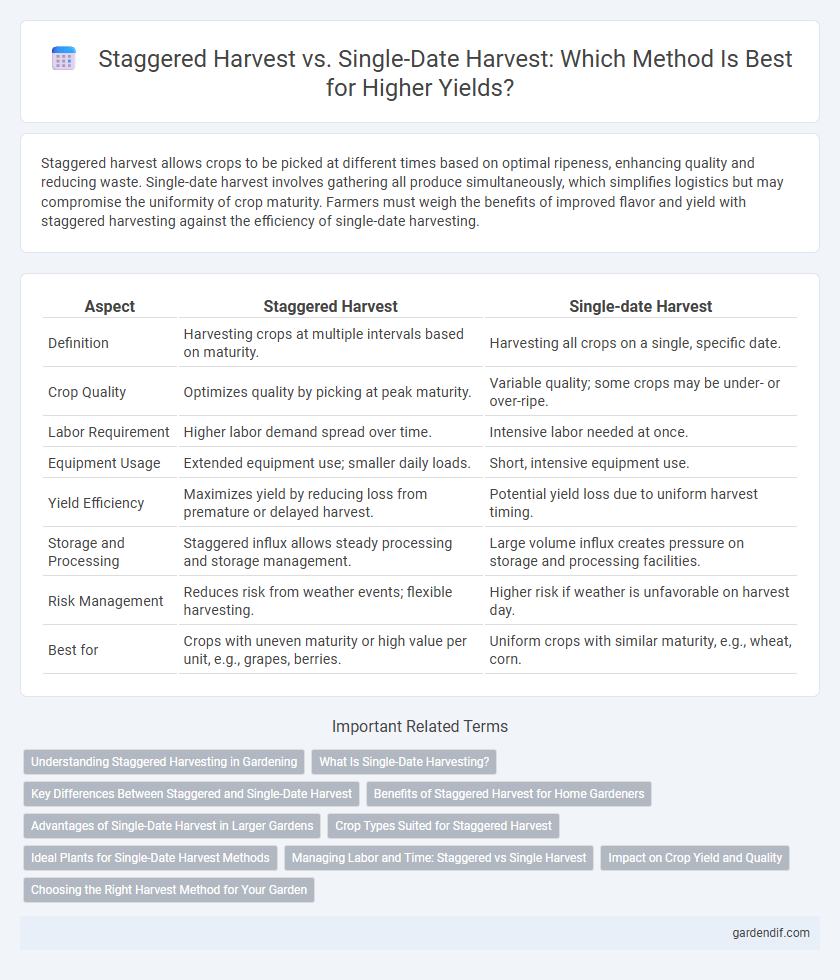
Staggered harvest vs Single-date harvest Illustration
Staggered harvest allows crops to be picked at different times based on optimal ripeness, enhancing quality and reducing waste. Single-date harvest involves gathering all produce simultaneously, which simplifies logistics but may compromise the uniformity of crop maturity. Farmers must weigh the benefits of improved flavor and yield with staggered harvesting against the efficiency of single-date harvesting.
Table of Comparison
| Aspect | Staggered Harvest | Single-date Harvest |
|---|---|---|
| Definition | Harvesting crops at multiple intervals based on maturity. | Harvesting all crops on a single, specific date. |
| Crop Quality | Optimizes quality by picking at peak maturity. | Variable quality; some crops may be under- or over-ripe. |
| Labor Requirement | Higher labor demand spread over time. | Intensive labor needed at once. |
| Equipment Usage | Extended equipment use; smaller daily loads. | Short, intensive equipment use. |
| Yield Efficiency | Maximizes yield by reducing loss from premature or delayed harvest. | Potential yield loss due to uniform harvest timing. |
| Storage and Processing | Staggered influx allows steady processing and storage management. | Large volume influx creates pressure on storage and processing facilities. |
| Risk Management | Reduces risk from weather events; flexible harvesting. | Higher risk if weather is unfavorable on harvest day. |
| Best for | Crops with uneven maturity or high value per unit, e.g., grapes, berries. | Uniform crops with similar maturity, e.g., wheat, corn. |
Understanding Staggered Harvesting in Gardening
Staggered harvesting in gardening involves collecting crops at multiple intervals, allowing plants to reach optimal maturity for each harvest, leading to extended productivity and fresher produce over time. This method contrasts with single-date harvests, where all crops are gathered simultaneously, which can cause a surplus of produce that may spoil quickly if not used immediately. Implementing staggered harvesting improves yields by matching harvest times to individual plant growth cycles and reduces waste by spreading labor and consumption across weeks or months.
What Is Single-Date Harvesting?
Single-date harvesting involves collecting all crops from a field in one coordinated session, maximizing efficiency for uniform crop varieties. This method reduces labor costs and simplifies equipment use, but may risk quality if the entire crop is not uniformly mature. It is ideal for crops with synchronized maturation, such as wheat or barley, where timing is critical for optimal yield and quality.
Key Differences Between Staggered and Single-Date Harvest
Staggered harvest involves collecting crops at multiple intervals, allowing optimal ripeness and reducing the risk of crop loss due to weather variability, while single-date harvest gathers all produce at once, maximizing operational efficiency and simplifying logistics. Staggered harvest requires more labor management and can lead to higher costs, but improves quality control and market flexibility. Single-date harvest benefits from lower labor expenses and easier planning but may compromise crop quality if harvesting occurs before or after peak ripeness.
Benefits of Staggered Harvest for Home Gardeners
Staggered harvest extends the home gardener's yield by allowing crops to mature at different times, reducing waste and ensuring a continuous supply of fresh produce. This method enhances plant health by minimizing the risk of pest infestations and diseases that can occur when all plants are harvested simultaneously. Home gardeners benefit from easier garden management and a more efficient use of space, leading to better overall productivity and sustainability.
Advantages of Single-Date Harvest in Larger Gardens
Single-date harvest in larger gardens simplifies resource management by concentrating labor and equipment usage into a defined period, enhancing operational efficiency. It enables precise timing for optimal crop maturity, reducing losses due to overripe or underripe produce. This approach also streamlines post-harvest processing and market distribution, ensuring consistent product quality and improved economic returns.
Crop Types Suited for Staggered Harvest
Certain crop types, such as grapes, apples, and tomatoes, benefit significantly from staggered harvest due to their varying ripening times and sensitivity to climatic conditions. Staggered harvest allows for optimal fruit quality and maximum yield by enabling selective picking at peak ripeness. Perishable crops with uneven maturation patterns are especially suited for this method compared to grains and root vegetables that are typically harvested in a single-date event.
Ideal Plants for Single-Date Harvest Methods
Ideal plants for single-date harvest methods typically include those with uniform ripening patterns, such as wheat, barley, and certain apple varieties. These crops benefit from synchronized maturation, allowing efficient harvesting operations and minimizing quality variations. Single-date harvesting reduces labor costs and enhances logistics, making it suitable for large-scale, mechanized farming systems.
Managing Labor and Time: Staggered vs Single Harvest
Staggered harvests distribute labor demands over a longer period, reducing peak workforce requirements and allowing for more flexible scheduling, whereas single-date harvests concentrate labor needs into a short timeframe, often necessitating a large, temporary labor force. Managing time in staggered harvests improves operational efficiency by aligning harvest windows with optimal crop maturity, while single-date harvests may risk quality loss due to time constraints. Efficient labor allocation and time management are critical for maximizing yield quality and minimizing post-harvest losses in both harvesting strategies.
Impact on Crop Yield and Quality
Staggered harvest allows crops to be picked at peak maturity, enhancing overall yield and improving quality by reducing overripe or underripe produce. Single-date harvest can simplify logistics but risks lower crop quality due to uniform picking regardless of individual maturity variations. Optimizing harvest timing based on crop growth stages directly influences nutrient content, flavor profiles, and shelf life.
Choosing the Right Harvest Method for Your Garden
Choosing between staggered harvest and single-date harvest depends on your garden's crop variety and usage needs. Staggered harvest spreads picking over weeks, ensuring a continuous supply of fresh produce and minimizing waste. Single-date harvest suits large-scale preservation and simplifies labor but may lead to oversupply and faster spoilage.
Staggered harvest vs Single-date harvest Infographic

 gardendif.com
gardendif.com